Are you a newly solo lawyer looking to get your first clients?
Or perhaps you work for a mid-sized law firm that could use some help generating a marketing strategy for new leads?
In addition to asking for more reviews and referrals, have you considered revamping your online presence — updating your law firm’s website, writing blog content, and branching out into online content marketing?
In this post, I’ve compiled the top legal marketing ideas to help lawyers and law firms expand their digital reach to attract new clients and generate leads.
See how Kaleidico can help you reach lead generation goals and get the best cases.
Law firm website design tactics to win over visitors
First, you’re going to need a website. Follow these tips to make sure your website is fully functional and has the essential pages and features to help your audience get the information they need.
1. Revamp your law firm’s branding and mission statements
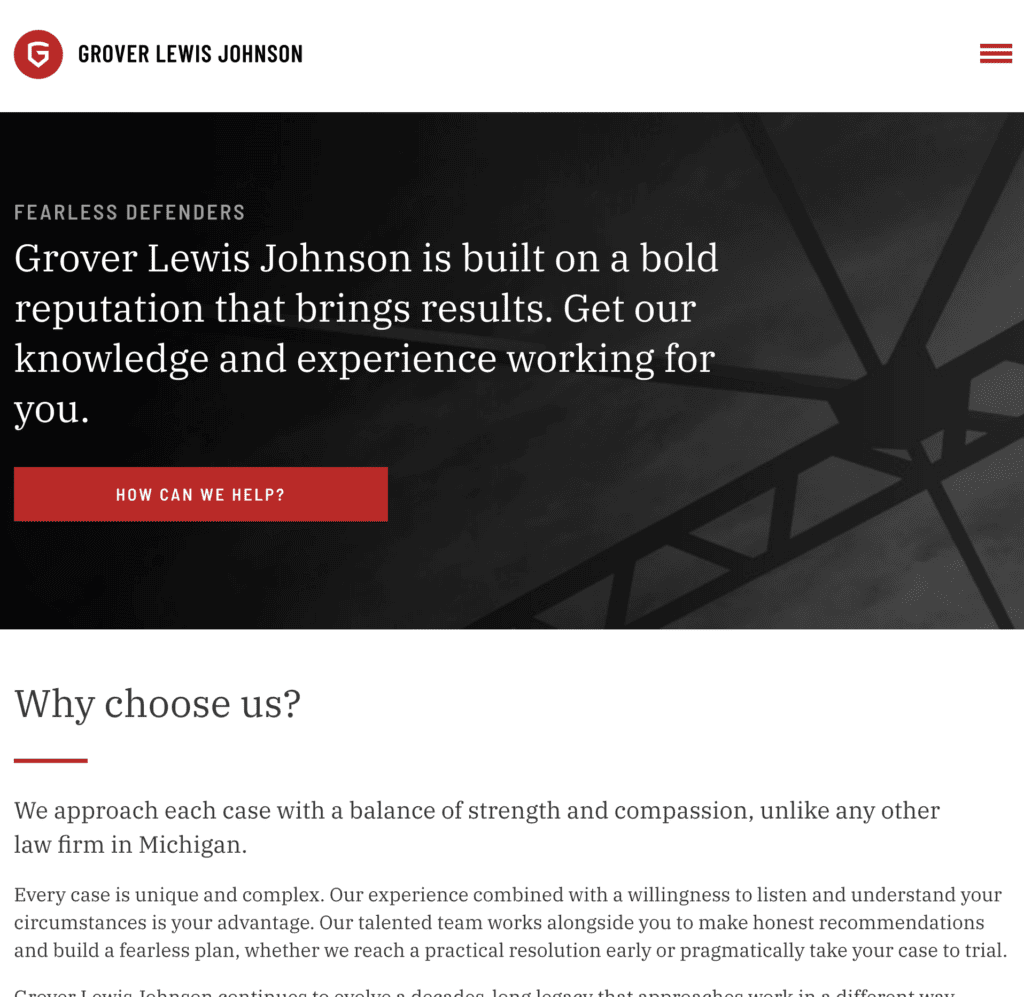
Choose the specific words, colors, and typefaces that convey your law firm’s core values and mission statement.
To come up with your mission statement, find your firm’s core values, purpose, and services to create a short but powerful statement. For example, “compassionate attorneys helping medical malpractice clients who suffered needlessly.”
Your mission statement should sit at the very top of your website to welcome visitors to your site. It tells visitors exactly who you are, who you help, and what services you offer.
Work with a graphic designer to discuss your branding goals, They’ll be able to find the right fonts, and colors, and create a custom logo that will stand out among the generic law logos online.
2. Create a landing page for each of your key practice areas
You’ll need to create individual pages on your website for each of your law firm’s key practice areas.
For example:
- Medical malpractice
- Preventable death
- Personal injury
- Car accidents
- Accidental death
- Divorce
It’s not enough to just have a homepage that lists out all of your legal services, you need to create a new page for each service. Why?
- Each new page is an opportunity to add essential keywords that will make your website easier to find
- You can go more in-depth on each topic and answer relevant questions your readers may have
- Multiple pages will keep readers on your website longer
- Each page will have its own contact form, multiply your chances of generating leads
- Makes it easier for Google to find and rank your sites
3. Add social proof to gain your readers’ trust
Be sure to list every certification and award your law firm has won as “social proof” and display them prominently on your website’s homepage, usually lower on the page or near the footer.
For example, feature graphics that show your law firm is part of the state bar or has won the “best local law office” award.
If your company is famous for working on a high-profile case, you should reference the case on your home page or on your “About Us” page.
This gains trust and makes your website easier to find on the Google search results page, particularly if people are Googling your high-profile case.
Lastly, add client testimonials to your website using a review plugin. A review plug will give you more control over which reviews you decide to show on your website.
Take advantage of the 2025 trend: Bite-sized content
Take your testimonials a step further and have successful clients create their own! This could be as simple as filming a quick blurb in your office on a mobile device.
Ask clients whose cases you’ve won to discuss their experience with your firm in a 30-60-second clip.
Low maintenance doesn’t have to mean low effort. Film the client under good lighting, ensure they can be heard clearly on video, and simply upload it to your social media or website.
Potential clients will feel better knowing that they have a face to associate with these reviews and that they’re real people who your firm has helped.
4. Make sure your website has all the essential pages
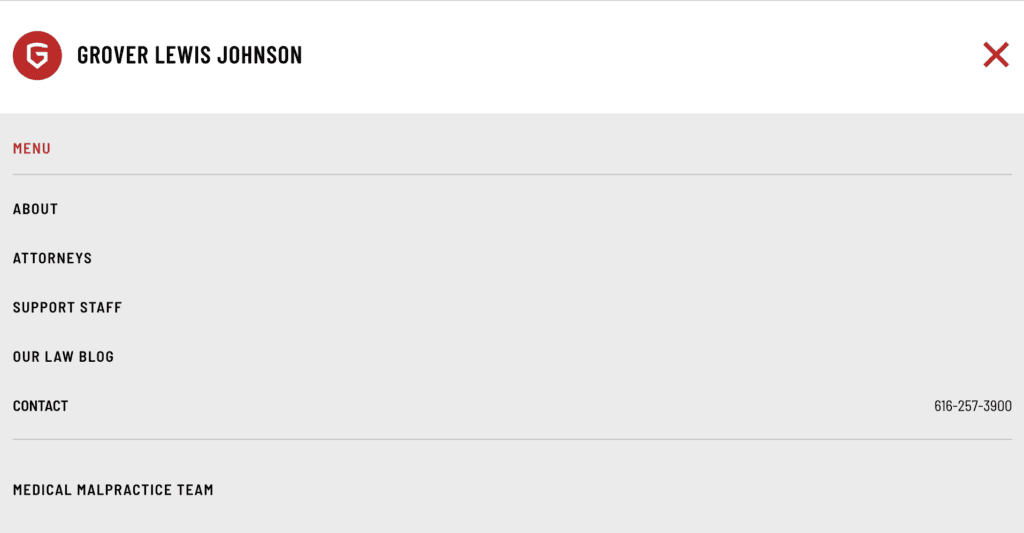
Every web user is accustomed to seeing these top five pages listed at the top of each website:
- Homepage
- About Page
- Blog page
- Practice Areas and Services page
- Contact page
At the very minimum, you need to have these pages to offer your readers enough information to help them, and enough keywords for Google to notice your website and place it in the search results.
Also, make sure to add important information in the footer of your website, such as:
- Physical location address
- Email address
- Phone number
- Copyright notice
- Social media icons
- Email sign-up forms
- Logo
- Sitemap
5. Attorney Bios
Once you’ve added all the basic pages, you should really create an “Attorney Bios” page. This is a page that features the attorneys on your team with a headshot and a short biography.
There are two benefits to doing this:
- It’s reassuring for readers to see what the lawyers look like and learn their qualifications.
- When people search for a specific lawyer on Google, your law firm’s website will be near the top of the search results.
Website SEO and local SEO tactics
Search engine optimization (SEO) simply means making your website or blog posts easy to find in Google searches.
The goal of your law firm’s SEO is to rank your website higher than your competitors to receive more traffic.
6. Google Business
If you want your law firm to appear as a red pin in Google Maps searches, then you’ll need to add or claim your Google Business profile.
Once you’ve claimed your profile, follow these steps to optimize your Google Business profile for better visibility on search engine results pages:
- Add your location on Google Maps
- Enter your physical address
- Make sure to delete any redundant or duplicate listings for your company
- Add your law firm’s phone number and website address
- Add links to LinkedIn and social media pages
- Add business hours
- Add photos of your location, office space, and staff
- Add questions and answers to your profile page
What’s in store for Google My Business in 2025
Google My Business will likely evolve in 2025 to keep up with the latest digital marketing trends. This will probably mean deeper integration with Google Search and Maps, more detailed local listings, and AI-powered recommendations. This is all the more reason to ensure your profile and information are up-to-date.
By adapting to these trends and optimizing their GMB profiles, businesses can improve their online visibility and attract more local customers.
Later in this article, we’ll discuss the importance of getting Google Business reviews to make your law firm rank higher in the “lawyer near me” Google search for your local area.
7. A help page or FAQ page for a fast track to Google’s SERP
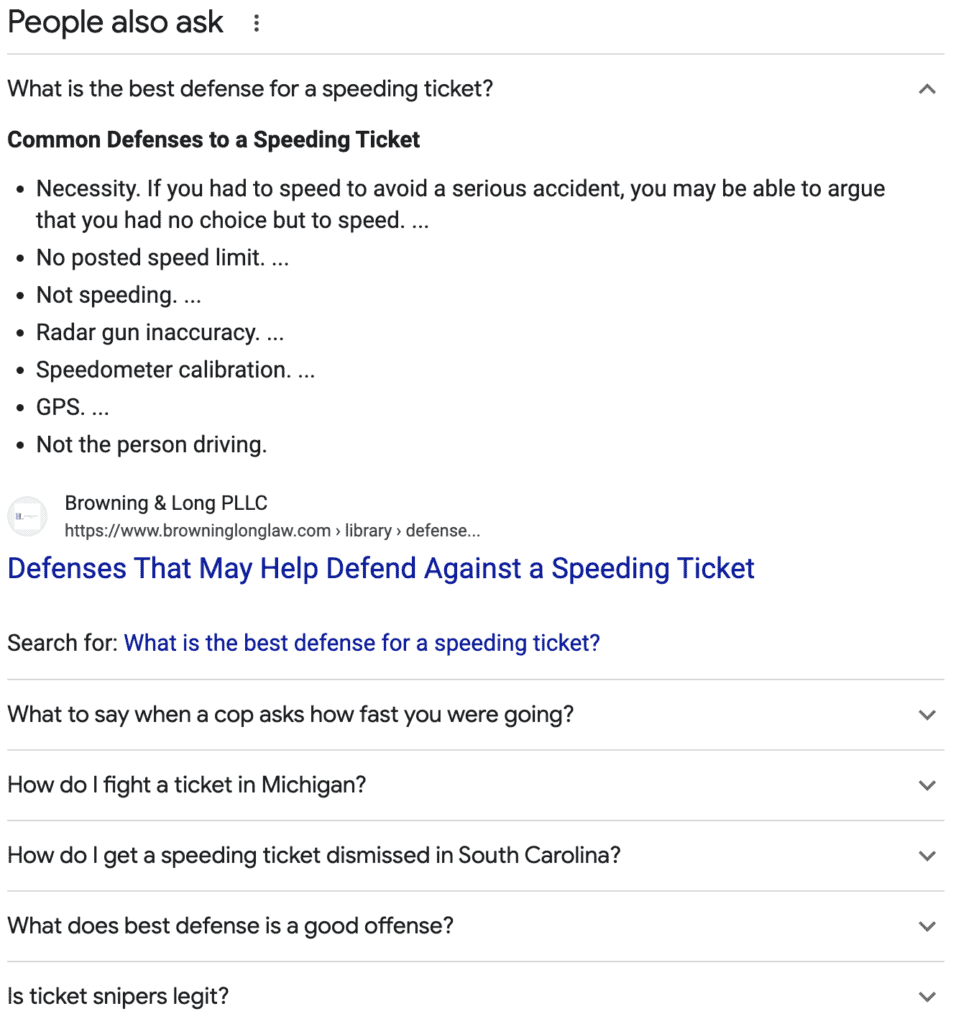
Have you noticed how sometimes you ask Google a question, and the first search result will be a sentence or paragraph with the answer bolded for quick access? Other times, related questions are shown in the “people also ask” box on the first page.
This is an example of a “featured snippet” from a FAQ or help page on a website.
This is why you should create a frequently asked questions page or help page that’s filled with the most common questions you receive from your clients.
To get your snippet to show on the first page, the following formatting:
Ask the question in the form of a header on your website. Then, follow it with a plain text answer. I’ll give you an example:
“How do I get my FAQ page questions on a Google SERP snippet?
You get your search snippet shown by immediately answering the question to your header’s question, usually in the first sentence.”
8. Getting reviews online
First, you should know there are some extra ethical rules and regulations for lawyers advertising their legal services, both traditionally and online.
I recommend you learn more about this from our blog post Ethical Regulations in Legal Marketing, however, I’ll simplify one interesting point regarding online reviews:
“(b) A lawyer shall not compensate, give or promise anything of value to a person for recommending the lawyer’s services…”
There is, however, an exception that lawyers can “(5) give nominal gifts as an expression of appreciation that are neither intended nor reasonably expected to be a form of compensation for recommending a lawyer’s services.”
What’s considered a “nominal gift”? I’m not a lawyer, so I can’t really say. I’ve read definitions of nominal gifts ranging from under $15 to under $50. So, if you plan on giving gifts, do your research ahead of time.
But essentially, the rule says this: You can’t pay people to recommend or leave reviews for your law firm, including Google Business reviews.
However, you can—and should—ask your previous clients for reviews online; you just can’t bribe them or harass them into doing so.
Legal content marketing ideas and tactics
For law firms, content marketing means producing free content, such as blogs or downloadables, and publishing them online to be found in Google searches, or while your audience is browsing online.
Content marketing is essential for lead generation — you create informative content that people search for to bring them to your website, where they eventually fill out a contact form.
9. Competitive research
A big part of marketing professionals’ jobs is to research the competition — see how much traffic they’re getting, which of their posts are ranking high on Google, and which specific keywords each law firm is ranking for.
Why do this?
Because if you know which blog posts and search terms are bringing people to your competitors’ sites, you can then copy their approach to bring those same people to your website.
Of course, when I say “copy,” I don’t mean to plagiarize.
Your job is to take the article the competition has written and entirely rewrite it to make it better, longer, and more updated. Google favors newer blog posts over older ones, so look to your competitors for inspiration and then give your readers a newer version to read.
If you notice a competitor has a top blog page that says “The Complete Guide to Winning Your Personal Injury Case” you could write a similar article titled “How To Win Your Personal Injury Case: Everything You Need to Know.”
If you’ve ever wondered why so many blog posts have similar titles, it’s exactly because of this — they’re competing for the same keywords.
Attract more qualified case leads to your law firm with our results-driven marketing services.
10. How-to blogs and educational content
Your website needs to be publishing blogs fairly regularly.
As a rule, four a month is the minimum you should produce. For highly competitive spaces like legal services, you’d benefit from producing even more blogs monthly.
Besides looking to your competitors for blog post ideas, you can also think about the types of content your target audience would search for.
Write blogs based on your key practice areas in the form of “how-tos” or educational posts. For example:
- “When to Know the Right Time to Sue for Medical Malpractice”
- “How to Sue Your Partner for Custody Rights”
- “How to Prove Medical Malpractice”
- “What Documents Do You Need to Prove Citizenship?”
As I mentioned before, you should create a separate FAQ page with short questions and answers. However, for blog posts, you should aim for at least 1000 words per article.
Make sure to organize your information into different subheadings for improved readability.
Also, you have to make sure you use your targeted keyword enough to get picked up in a Google search but not so much that it seems spammy or too obvious.
Optimized content for machine learning
If you’ve searched for anything on Google recently, you’ll have noticed that they’re already rolling out AI integration into their search results to enhance user experience. This means that businesses will have to be on their A-game when it comes to content in order to have a better chance of appearing in results.
Optimization should include:
- Ensuring your content is top-quality and original, focusing on the Expertise, Authoritativeness, and Trustworthiness (EAT) principles.
- Creating content that’s keyword-focused and rich in related terms and phrases to clearly convey the topic.
- Getting to the content itself should be easy for the user, and your web pages should be optimized for mobile use.
- Stay updated on the latest changes to Google’s algorithm, and you’ll stay ahead of your competition.
Following these guidelines is a great start to improving your website’s visibility in search engine results and attracting more organic traffic.
11. Video content
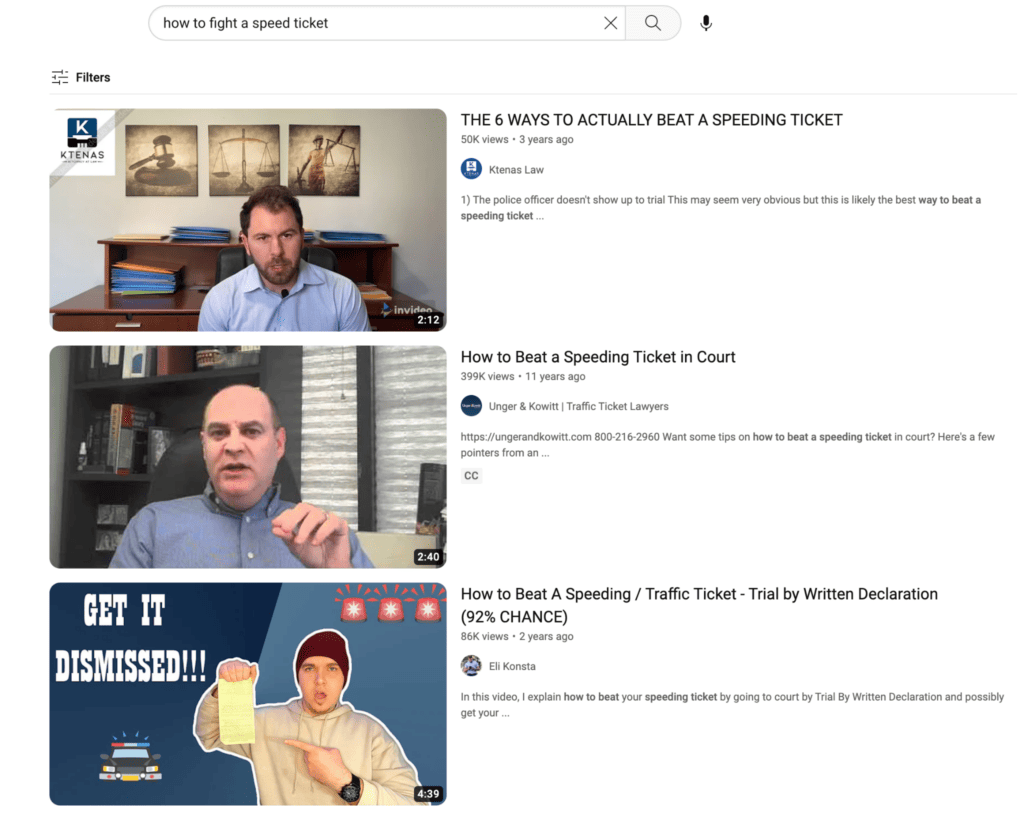
Most law firms do not produce educational or even promotional videos.
Writing blog posts, while time-intensive, isn’t as hard as video editing. Therefore, there’s a lot less competition out there for lawyers who post high-quality videos on YouTube.
So you want to get discovered quickly? Create a high-quality YouTube video and optimize it with timestamps in the description.
I’ve seen examples of new YouTube videos that were only one day old that made it to Google’s first page of search results. It’s kind of crazy how that works sometimes.
Just like text-based snippets in Google’s SERP, there are also video snippets that will play a video at the right time to answer a searcher’s relevant question.
Your YouTube video can then be embedded onto your website, even your homepage to greet visitors when once they click.
Lead generation tactics
Once you’ve got traffic to your website, you’ll need a few different tactics to encourage people to submit their contact info. Follow these tactics to optimize your website for lead generation.
See how Kaleidico can help you reach lead generation goals and get the best cases.
12. Forms on every one of your pages
The generic law firm website will have forms everywhere — pop-up ads, chat boxes, forms in the sidebar, and click-to-call buttons at the top of the website.
This approach can be a bit overkill and potentially desperate looking. I know when I’m searching through sites I get easily annoyed with all the pop-ups. All people feel this way.
Instead, each page will have forms with clear calls-to-action (CTA).
Instead of bombarding visitors with contact forms everywhere, find ways to sneak in clickable buttons on the website.
When people click these buttons, they’ll either be taken to a different page or an attractive pop-up will appear asking one simple question at a time until the form has been completed.
Don’t misunderstand what I’m saying, you do need contact forms throughout your website, but show some restraint so you don’t scare visitors away.
13. Chat Boxes
Yeah, I know I just said I don’t like chat boxes. Usually, it’s the ones that have a really loud “DING” when you visit the website. Nobody likes that.
But, chat boxes do have their purpose. They are another way to capture a lead and to ask qualifying questions to people who are interested in your services.
We can’t talk about chat boxes without discussing the prominence of AI in this space and how that’s expected to increase in 2025.
AI-driven chatbots have become a powerful tool for businesses to enhance customer engagement and streamline operations. These chatbots can be integrated into websites to provide instant support, answer queries, and guide users through various processes.
Use the following platforms to drive growth and improve customer service:
- ChatGPT
- Dialogflow
- Microsoft Power Virtual Agents
- Drift
- Zoho SalesIQ
14. Lead magnets, downloadable content
If your visitors aren’t comfortable or willing to fill out a contact form, they may be willing to enter their email address to receive a free content download, called a “lead magnet.”
In addition to blog posts, consider writing a lengthy PDF eBook that people can download for free. And the only requirement is that they submit their name and email address so you can email them their download.
15. Webinars
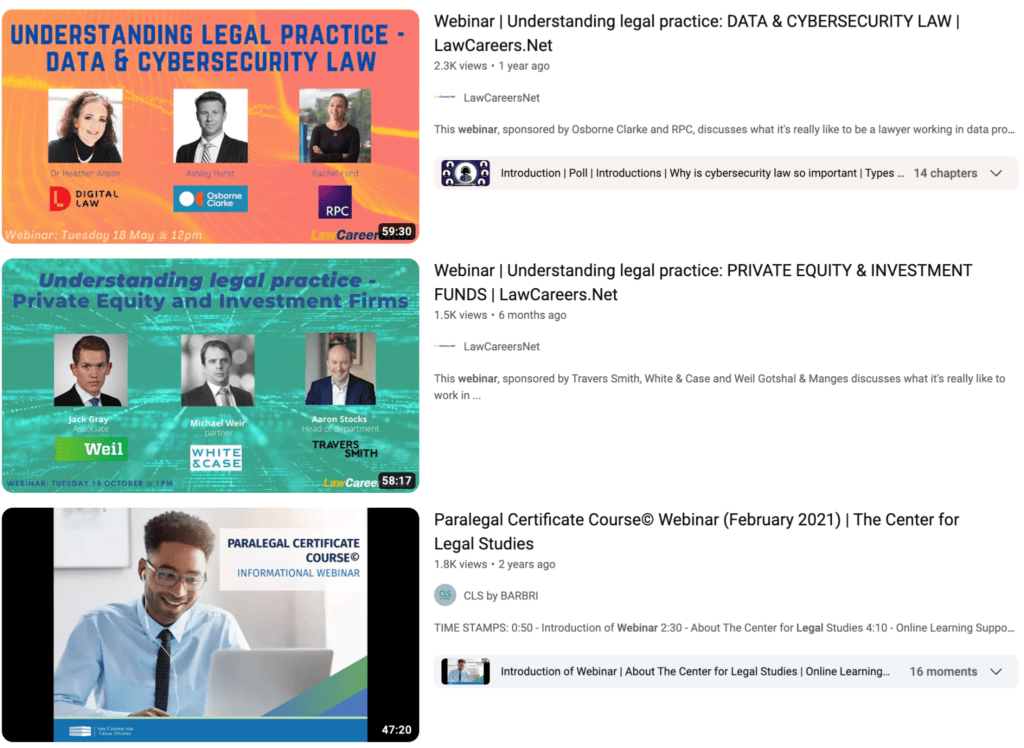
You may consider hosting an online seminar or, “webinar,” to provide basic legal information to people who are interested.
A webinar is a live interactive presentation that can be used to educate, engage, and convert potential clients or attract new leads.
Follow these tips to come up with new webinars:
- Choose a topic related to your target audience and practice area such as “Estate Planning for Business Owners”
- Determine the format, whether it will be live or pre-recorded. Live webinars are typically better for engagement and lead generation.
- Promote your webinar on social media posts, emails, and your website.
- Create visual aids such as slides and videos to enhance your presentation
- Make time for Q&A sessions at the end
- Follow up after the webinar with attendees
- Gather feedback and questions from your podcast to turn into blog posts, emails, and social media content
16. Guest star on a podcast or create your own legal podcast
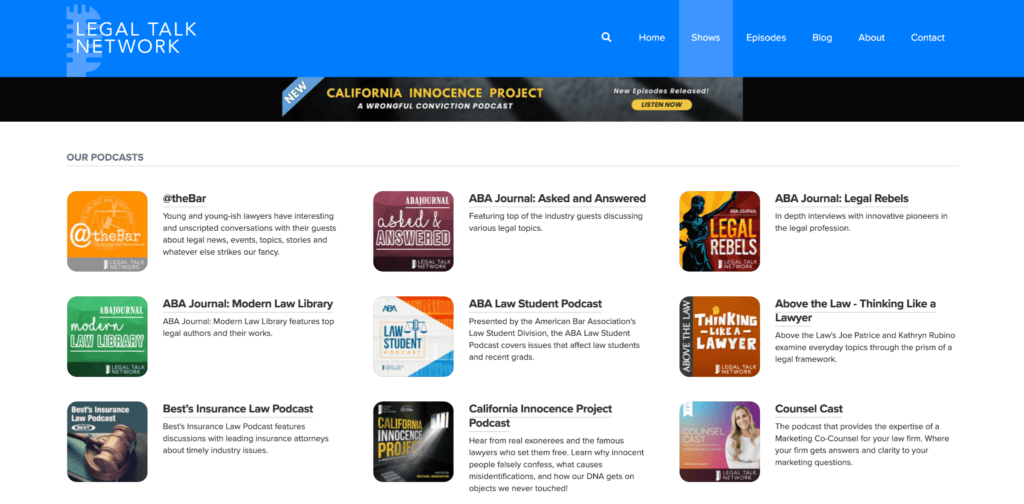
Podcasts are becoming increasingly popular in 2023 and they can be a good way for lawyers to showcase their expertise in their practice areas and reach potential clients.
Consider reaching out to legal podcasts and offering to be a guest speaker to discuss relevant legal topics or your experiences as a lawyer.
If you have the time and drive, start your own podcast and share your legal knowledge and insights with a wider audience.
Here are some great legal podcasts for inspiration:
- Legal Talk Network
- Above the Law
- ABA Journal
- The Lawfare Podcast
- Amicus with Dahlia Lithwick
- The Lawyerist Podcast
- The Happy Lawyer Project
- Law School Toolbox Podcast
17. Influencer marketing
As a lawyer, you want to work with influencers online who have a large following in your target audience that are relevant to your area of practice.
For example, if you’re a personal injury lawyer, you may want to work with a local influencer in the fitness or sports industry, as their audience is more likely to suffer from injuries that require legal representation.
There are several websites that can help you find influencers in your industry or niche. Similarly, you may want to just browse Facebook or Instagram for popular influencers who are local to your area.
Be advised: there are specific rules and regulations governing how lawyers can use influencer marketing. For example, in the US, lawyers cannot pay others to recommend their services unless they are disclosed as advertisements.
Related reading: Ethical Regulations in Legal Marketing.
Big in 2025: Microinfluencing
Micro-influencers are a significant trend in 2025, offering businesses a more authentic and cost-effective approach to influencer marketing.
Forget shelling out money for the top dogs; micro-influencers are those with an online audience in more niche markets. This helps to focus your marketing efforts on the most relevant audience likely to benefit from your service.
To find the right micro-influencer for your firm, search the pages your followers follow. Pay attention to any other pages or figures that frequently show up. You can also search relevant hashtags on your preferred social media site. Don’t count out forums like Reddit either; search relevant subreddits for frequent users likely to influence the rest of the community.
Other platforms to find and manage influencer campaigns include:
- HypeAuditor: This platform allows you to search for influencers based on various criteria, including follower count, engagement rate, and audience demographics.
- AspireIQ: This platform helps you find and manage influencer campaigns, track performance, and measure ROI.
- Upfluence: This platform connects brands with influencers and provides tools to manage influencer campaigns.
18. Interactive content
Getting somebody to fill out a form on your website may be difficult. This is where interactive content comes in.
Interactive content is digital content that engages the user and requires their participation, such as:
- Quizzes
- Questionnaires
- Assessments
- Calculators, such as the “Personal Injury Settlement Calculator”
- Interactive maps
Also, make sure to promote your interactive content through social media, email marketing, and other channels besides your law firm’s website to maximize its reach and impact.
19. Thought leadership
Have you considered raising your profile to be a “thought leader” online?
Thought leaders are authorities and experts in their fields who routinely publish information to help shape the conversation around a particular issue or topic.
Is there a new sweeping law people should know about?
Is there a high-profile criminal case people are talking about?
Become a more prominent legal expert online to build your credibility:
- Create a weekly or monthly newsletter that stays in touch with clients and new prospects. Talk about the news, recent cases, and updates on the law.
- Shoot short videos for Instagram and YouTube. Short-form video content is an emerging trend in 2023. Keep the videos to a couple of minutes and discuss recent legal news.
- Attend industry events and conferences
- Publish articles in industry publications
- Collaborate with other professionals in your industry
- Host a podcast or be a guest on a podcast
20. Video testimonials
Video testimonials can be your most powerful tool for legal marketing and help provide “social proof” of your firm’s expertise and success.
Tips on recording video testimonials of former clients (just keep in mind you cannot incentivize their feedback as this breaks Rule 7.2 of the AMA legal advertising regulations):
- Identify satisfied clients and only reach out to them to see if they’re willing to provide a video testimonial
- Provide guidelines such as what to wear, what you want them to talk about in the video, the outcome of their case, and how your firm helped them
- Record in a professional setting with good lighting and sound quality. Keep the camera stable and in focus.
- Edit the video to keep it short and remove any awkward moments
- Share the video on your law firm’s website, social media channels, email channels, and other marketing materials
21. Community involvement
Look for local events that fit into your target audience.
For example, a criminal defense attorney may attend law enforcement events while a family law attorney may attend events hosted by local parenting or divorce support groups.
Lawyers can also look for opportunities to get involved with local businesses, such as sponsoring events and sports teams and providing legal services to small business owners.
Do a Google search for networking events, local charities, non-profit organizations, community service organizations, and other local business associations for inspiration.
2025 trend: Transparency
Consumers in 2025 want to know who or which causes you and your firm support.
With more and more consumers using their dollars to take a stand, social transparency is one way to earn customer loyalty and build your brand’s name.
Be public with the local or global organizations and initiatives that your firm supports. Post pictures of the events your firm attends or sponsors. Clients will respond positively to businesses that align with their values.
22. Mobile optimization
Did you know that half of the people visiting your law firm’s website are viewing it on their smartphones?
One of the emerging SEO trends for 2023 is improving mobile responsiveness on websites. This means when you view the website on your phone, it automatically resizes for an optimum browsing experience for your phone.
By the way, you’d be surprised how many law firms’ websites are NOT mobile-friendly! I can almost guarantee you people immediately leave these websites if they’re viewing them on their phones.
If you’re planning on generating leads from a contact form on your website, then your website must be mobile-friendly, or else people will never fill out those forms.
23. Email marketing
Are you using email marketing to stay in touch with former clients and new leads who aren’t quite ready to start their cases? If not, you need to be.
Follow these steps to set up your legal email marketing strategy:
- Choose the right email marketing platform such as Mailchimp, Constant Contact, or Drip.
- Then, segment your audience based on their interests, behavior, and such as “Family Law Clients” “Criminal Defense Clients” and “Personal Injury Clients.”
- Start writing and publishing blogs on your website related to legal scenarios, e.g. “How to Fight a DUI Without Going to Court.”
- Set up drip campaigns, which are automated email sequences that get automatically sent each time a person downloads content, opens an email, or performs a trackable action.
- Use clear and concise subject lines, and calls-to-action (CTAs), and avoid spammy trigger words so your email gets sent to the user’s inbox and not their spam folder.
- Don’t overdo it! Stick to a monthly newsletter and set up the drip campaign to automatically send them emails after they’ve taken the next steps.
24. Data analytics
Keeping track of your data and analytics isn’t so much an idea as it is an important part of your marketing strategy — without measuring your data you won’t know if your efforts are successful or not.
Here are some specific ways lawyers can use data analytics to improve their marketing efforts and reach more potential clients:
- Use website analytics such as Google Analytics to track website traffic, bounce rates, and time spent on the site.
- Use social media analytics tools to track engagement rates such as likes, comments, and shares to see what types of content are the most popular
- Use built-in email marketing analytics to measure email open rates, click-through rates on the links in those emails, and conversion rates. By tracking this, you’ll see what kinds of emails get opened, and which ones don’t get opened.
- Customer relationship management (CRM) like Salesforce and HubSpot help you keep track of each interaction with clients to keep track of how many touchpoints you have with the client and quickly memorize the past interactions.
25. Offer a “free consultation”
Offering a free consultation or a “no-cost consultation” is one of the best tactics for meeting potential clients.
This offer will be one of your main calls-to-action (CTA) on your website and will likely be included at the bottom of every web page and blog post on your website.
Tips on how to offer a free consultation on your website for better conversions:
- Make it clear, such as “Schedule us for a free consultation” in a hyperlink or clickable button
- Be specific about the length of the consultation, such as “Our consultations typically last 30 minutes”
- Make it easy to schedule by including a calendar appointment app on your website such as Calendly
- Set expectations and be honest about what they can expect from working with your firm
- After the consultation, follow up with the potential client to answer any remaining questions
26. Develop a referral program
As of my understanding (remember, I’m not a lawyer but a marketing writer), the American Bar Association’s Model Rules of Professional Conduct do not explicitly prohibit lawyers from offering referral programs.
However, lawyers must be careful to avoid any activity that may be seen as giving something of value for recommending their services. Be sure to check out your jurisdiction’s laws before following the referral program steps:
- Find potential referral sources such as other lawyers, clients, and family members
- Determine the rewards, whether it’s small gift cards, a discount on services, or charitable donations.
- Create a referral program agreement that outlines the terms of the referral program including rewards, criteria for a referral, and any exclusions.
- Promote the program on your website, social media, and email marketing campaigns
- Track new referrals using a system and make sure the rewards are distributed appropriately
- Follow up with the referred new clients to provide excellent service
27. Create landing pages for a Google Ads PPC campaign
Have you set up a Google Ad campaign yet? First, in order to do so you must build a “landing page” for your ad. This is the page your visitors “land” on after clicking on your Google Ad.
Tips to consider when creating landing pages for a Google Ads campaign:
- Make sure the landing page is relevant to the ad. Don’t send people clicking on a “car accident” ad to a “truck accident’ page.
- Keep the language simple and use calls-to-action (CTAs) that tells the visitor to “Get a Free Quote Today!” or “Book A No-Cost Consultation.”
- Highlight the benefits of your law firm, showing social proof such as video testimonials and awards and certifications.
- Use strong visuals and a professionally designed landing page. (Nobody is going to fill out a contact form on a questionable website)
- Split test using A/B testing to test different variations of the same landing page to see if one page outperforms the other. (For example, people might respond better to the CTA “Get Your Compensation Today” over “Contact Us!”)
- Make sure your landing page is optimized for mobile!
For even more legal marketing ideas
Hire Kaleidico to handle your legal marketing and lead generation
Kaleidico is a law firm marketing agency, lead generation agency, and content creation studio for law firms.
Fuel your firm with qualified online leads created by our content strategists, PPC professionals, SEO specialists, blog writers, and editors.

